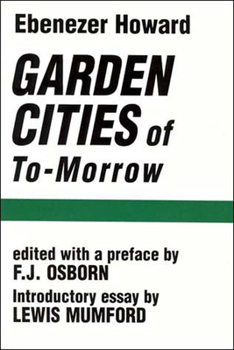Garden Cities of To-Morrow
Select Format
Select Condition 
Book Overview
The classic work that introduced the concept of the Garden City.
Originally published in 1898 as To-Morrow: A Peaceful Path to Real Reform and reissued in 1902 under its present title, Garden Cities of To-Morrow holds a unique place in town planning literature. The book led directly to two experiments in town-founding that have had a profound influence on practical urban development around the world. The book was also responsible for the introduction of the term Garden City, and set into motion ideas that helped transform town planning.
Format:Paperback
Language:English
ISBN:0262580020
ISBN13:9780262580021
Release Date:March 1965
Publisher:MIT Press
Length:168 Pages
Weight:0.48 lbs.
Dimensions:0.4" x 5.3" x 8.2"
Age Range:18 years and up
Grade Range:Postsecondary and higher
Customer Reviews
1 rating
ONE OF THE TRUE "CLASSICS" OF MODERN URBAN PLANNING
Published by Thriftbooks.com User , 15 years ago
Ebenezer Howard (1850-1928), who was actually a professional stenographer and court reporter rather than an architect, who lived in England nearly all of his life. In 1898 he self-published the first edition of this book, and proposed migration of populations from overcrowded urban centers (thus relieving their congestion) to sparsely-settled circular rural districts he called "Garden Cities"----so named from the greenbelt of undeveloped or agricultural land surrounded them, limiting the size and growth of the city. People would live and work in these cities, which would be cooperatively run by quasi-public organizations renting the property to tenants (both businesses and individuals). In the Introduction, Howard notes, "Palatial edifices and fearful slums are the strange, complementary features of modern cities." By way of contrast, "Garden City is not only planned, but it is planned with a view to the very latest of modern requirements, and it is obviously always easier, and usually far more economical and completely satisfactory, to make out of fresh material a new instrument than to patch up and alter an old one." He thought that Garden Cities would combine the best attractions of both "town" and "country," and would be just large enough to promote a full social life, and would be linked to each other by a rapid-transit system. At the end of chapter 10, Howard summarizes, "My proposal is that there should be an earnest attempt to organize a migratory movement of population from our overcrowded centres to sparsely settled rural districts; ... that the migrants shall be guaranteed ... that the whole increase in land values due to their migration shall be secured to them; that this be done by creating an organization which ... shall receive all 'rate rents' and expend them in those public works which the migratory movement renders necessary or expedient ... by so laying out a Garden City that, as it grows, the free gifts of Nature---fresh air, sunlight, breathing room and playing room---shall be still retained in all needed abundance, and by so employing the resources of modern science that Art may supplement Nature, and life may become an abiding joy and delight." This book is of abiding interest to utopians, those interested in intentional communities, New Towns, urban planning, the New Urbanism, and more. ESSENTIAL READING!





